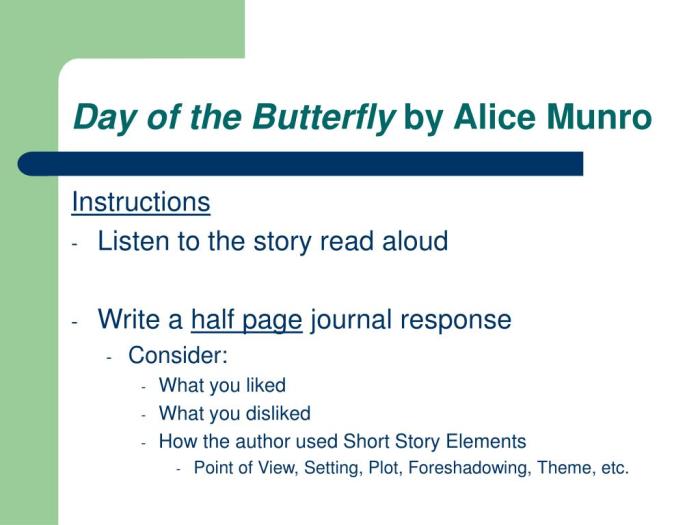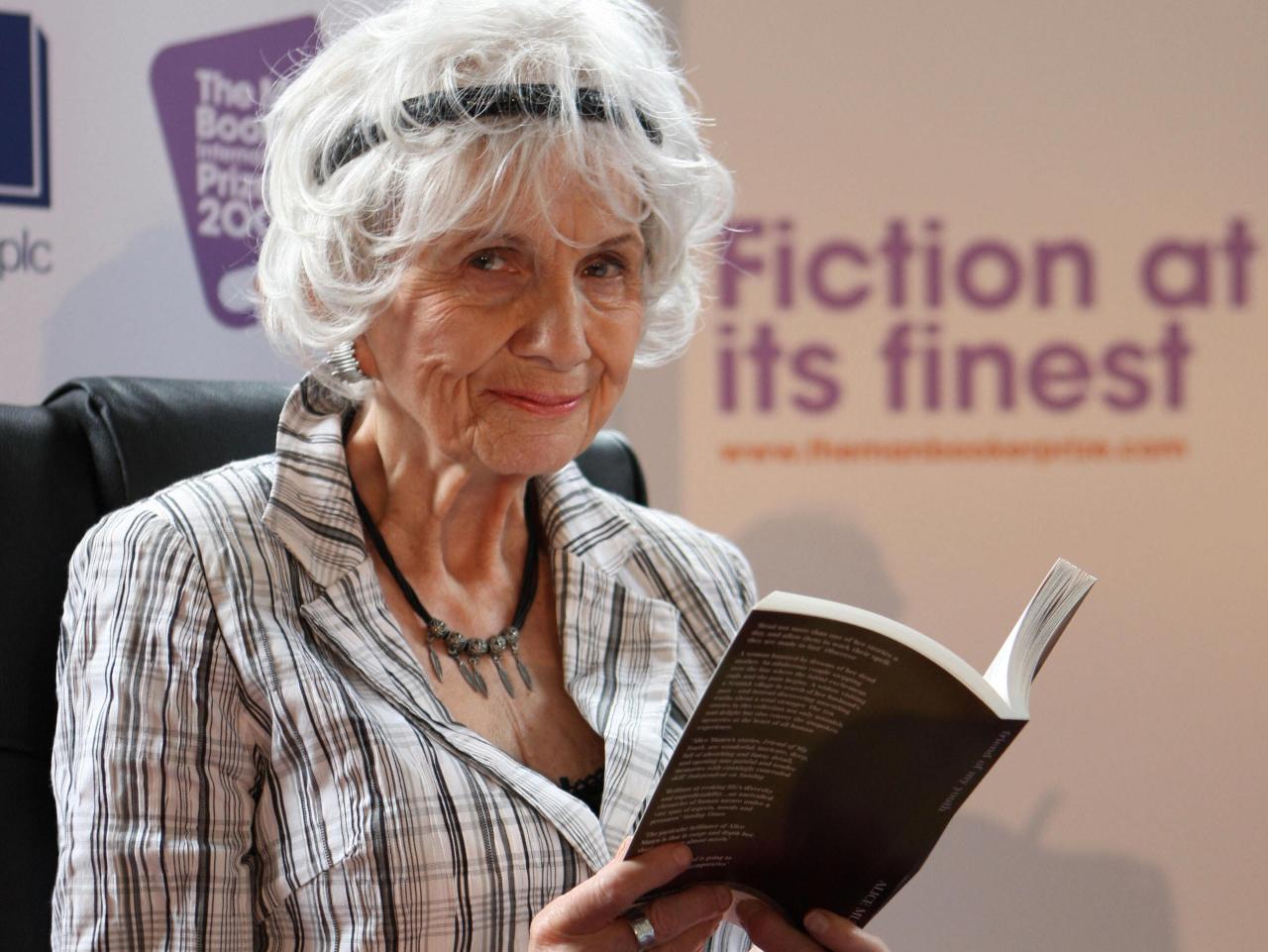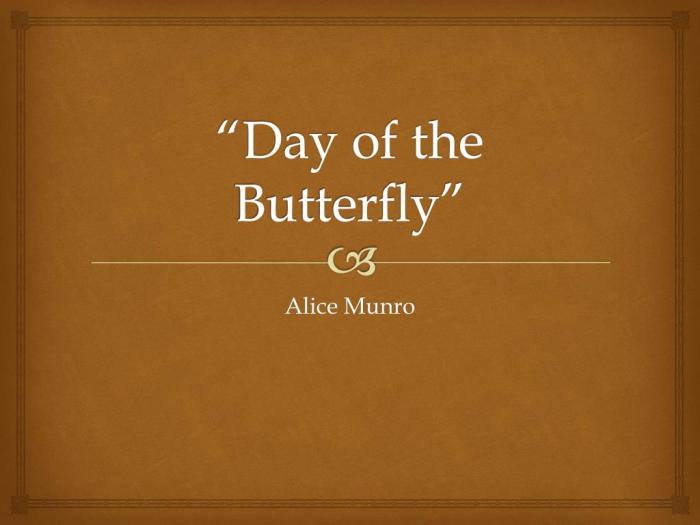Day of the butterfly alice munro – In Alice Munro’s captivating short story “Day of the Butterfly,” symbolism, characterization, and literary devices intertwine to explore themes of female agency, societal expectations, and transformation.
Munro’s skillful use of imagery and foreshadowing builds tension and immerses readers in the protagonist’s journey of self-discovery, making “Day of the Butterfly” a profound and unforgettable literary experience.
Literary Techniques

In “Day of the Butterfly,” Alice Munro employs various literary techniques to enhance the story’s depth and emotional impact. Symbolism, imagery, and foreshadowing play significant roles in conveying themes and creating a sense of suspense and foreboding.
Symbolism
The butterfly in the story serves as a powerful symbol of transformation and freedom. It represents the narrator’s desire to break away from societal expectations and explore her own path. The butterfly’s ephemeral nature also symbolizes the fragility of life and the fleeting nature of happiness.
Imagery and Metaphors
Munro uses vivid imagery to create a rich sensory experience for the reader. Descriptions of the natural world, such as the “shimmering heat” and the “sweet smell of hay,” evoke a sense of place and time. Metaphors, such as comparing the narrator’s life to “a tightrope” and her feelings to “a bird in a cage,” convey complex emotions and ideas in a concise and impactful way.
Foreshadowing
Throughout the story, Munro uses subtle hints and foreshadowing to build tension and create a sense of unease. The narrator’s recurring dreams of falling, her fears about her mother’s health, and the ominous presence of the stranger all foreshadow the tragic events that unfold.
Character Analysis

The character of Roberta in Alice Munro’s “Day of the Butterfly” embodies the complexities of female agency within a patriarchal society. Her relationship with her mother, societal expectations, and her own desires shape her choices and reveal the constraints and possibilities available to women in the mid-20th century.
Roberta as a Representation of Female Agency
Roberta’s character exemplifies the struggle for female autonomy within a society that often limits women’s choices. Her desire for independence and self-expression clashes with the expectations of her family and community. Through her actions, Roberta challenges traditional gender roles and asserts her right to make her own decisions.
Relationship between Roberta and Her Mother
Roberta’s relationship with her mother is a complex one, marked by both love and tension. Her mother’s traditional values and emphasis on domesticity contrast with Roberta’s more modern outlook. Roberta’s desire for a different life leads to conflicts with her mother, but ultimately, their bond remains strong.
Impact of Societal Expectations on Roberta’s Choices
The societal expectations of the time weigh heavily on Roberta’s choices. The pressure to conform to gender norms and prioritize marriage and family limits her opportunities. Roberta’s decision to pursue a career and her choice of partner reflect her defiance of these expectations.
Themes and Motifs

Alice Munro’s “Day of the Butterfly” explores several profound themes and employs a significant motif to convey them. The story delves into the complexities of relationships, the transformative power of experiences, and the influence of the natural world on human lives.
Motif of the Butterfly
The butterfly serves as a powerful symbol throughout the story. It represents transformation, growth, and the potential for change. The protagonist, Sheila, undergoes a profound transformation throughout the narrative, much like the metamorphosis of a butterfly. The butterfly’s presence in the story highlights the possibility of growth and renewal even in the face of adversity.
Setting, Day of the butterfly alice munro
The setting of the story plays a pivotal role in shaping its themes. The rural landscape of Ontario provides a backdrop for the characters’ experiences, mirroring their inner struggles and transitions. The natural world becomes a source of both solace and challenge, reflecting the characters’ search for meaning and connection.
Historical Context: Day Of The Butterfly Alice Munro

Alice Munro’s “Day of the Butterfly” is set in the mid-20th century, a period of significant social and cultural change. The story reflects the experiences of women during this time, particularly the challenges they faced in navigating traditional gender roles and societal expectations.
Changing Social Norms
The mid-20th century witnessed a gradual shift in social norms, particularly regarding women’s roles in society. The rise of feminism and the increased participation of women in the workforce challenged traditional expectations of women as solely wives and mothers. However, many women still faced societal pressure to conform to these roles, leading to internal conflicts and feelings of inadequacy.
Women’s Education and Employment
During this period, there was a growing emphasis on women’s education and employment opportunities. While women had traditionally been limited to domestic roles, the increasing availability of education and jobs allowed them to pursue their own interests and aspirations. However, women still faced barriers in the workplace, such as unequal pay and limited career advancement opportunities.
Impact on the Characters
The characters in “Day of the Butterfly” are affected by these social and cultural changes. The protagonist, Florence, struggles to balance her desire for independence with the expectations of her family and community. She feels torn between her traditional role as a wife and mother and her longing for a more fulfilling life.
Literary Devices

Munro employs various literary devices to enhance the narrative’s depth and emotional impact. Flashbacks and foreshadowing serve as crucial storytelling techniques, while similes and metaphors contribute to the vivid imagery and characterization.
Table: Flashbacks and Foreshadowing
| Feature | Flashbacks | Foreshadowing ||—|—|—|| Purpose | Transport readers to past events | Hint at future developments || Effect | Enrich character development and backstory | Build suspense and anticipation || Examples | Rose’s childhood experiences, Aunt Evelyn’s life | Rose’s dreams, the snake in the garden |
List: Similes and Metaphors
Munro’s use of similes and metaphors enhances the sensory experience and deepens the understanding of characters and events.
- Simile: “The old woman’s face was like a walnut, deeply lined and brown.”
- Metaphor: “The lake was a mirror, reflecting the sky’s changing moods.”
Diagram: Protagonist’s Journey of Self-Discovery
Rose’s journey of self-discovery unfolds through a series of transformative experiences. The diagram below illustrates the key stages of her evolution:
- Innocence: Naive and sheltered, Rose’s understanding of the world is limited.
- Awakening: Encounters with Aunt Evelyn and the snake in the garden challenge her preconceived notions.
- Confrontation: Rose confronts her own mortality and the complexities of human relationships.
- Growth: Through introspection and resilience, Rose develops a deeper understanding of herself and the world around her.
- Acceptance: Rose embraces the uncertainties of life and finds contentment in her own skin.
Q&A
What is the significance of the butterfly in the story?
The butterfly serves as a powerful symbol of transformation, representing the protagonist’s journey of self-discovery and liberation.
How does Munro use foreshadowing to create suspense?
Munro employs subtle hints and foreshadowing throughout the story, building tension and creating a sense of anticipation that keeps readers engaged.
What are the major themes explored in “Day of the Butterfly”?
The story explores themes of female agency, societal expectations, the power of memory, and the complexities of human relationships.